Palazzo Alliata di Villafranca
The Palazzo Alliata di Villafranca is a noble family's palace in the Palazzo Reale district of Palermo. It occupies the whole city block between the Cassaro and the back of Via dell'Università and the whole of a side of Piazza Bologni.[1][2][3]
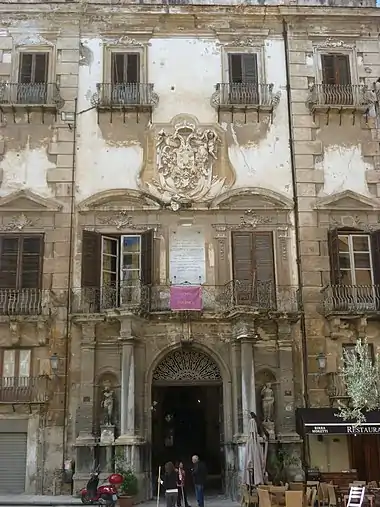
History
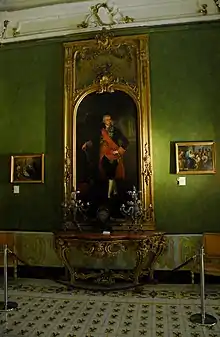
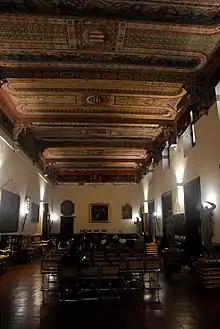
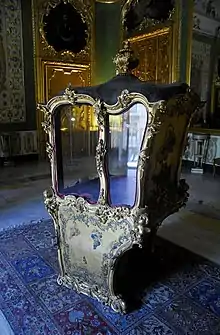

It originated in the 16th century as the home of the powerful Beccadelli di Bologna family, originally from Bologna but settling in Sicily during the Renaissance. One member of this family was Il Panormita, a famous poet of the late Aragonese court on the island. The family also gave its name to the piazza in front of the palace, previously known as the "Piano d'Aragona".
Between 1600 and 1650 the palace was acquired by the Alliata di Villafranca and it remained their main residence in Palermo until the late 20th century.[4] In the following century the palace was rebuilt to its current late 17th century appearance to designs by the architect Giovanni Battista Vaccarini.[5]
The monumental facade with two symmetrical doors recalls the era during which the building was used by the Kingdom of Sicily's postal service, as do a number of rooms on the ground floor.[6] The two large stucco coats of arms by Giacomo Serpotta show the heraldic arms of the Alliata as Princes of Villafranca.[1] A plaque on the centre of the main facade recalls Giuseppe Garibaldi's stop in the building in 1860:
In questa illustre casa
il 27 maggio 1860
per sole due ore
posò le stanche membra
GIUSEPPE GARIBALDI
---
Singolare prodezza
fra l'immane scoppio
delle micidiali armi di guerra
sereno dormiva
il genio sterminatoredi ogni tirannide
The palace houses one of the city's main art collections, including The Stoning of St Stephen and The Tribute Money (both painted in 1639 by Matthias Stom), a major Crucifixion by Anthony van Dyck, the 1791 Birth of Prince Giuseppe Alliata Moncada, son of Prince Fabrizio Alliata Colonna and Giuseppina Moncada Branciforte, with Abundance and Fame and with the Genius of Palermo Paying Homage by Desiderio De Angelis, Saint Joseph with the Christ Child (attributed to Pietro Novelli) and works by Francesco Lojacono, Mario Rutelli and Filippo de Pisis. The documents commissioning the Van Dyck are still in the family archive. As well as paintings on canvas and card, the building's art collections include drawings, prints and stucco medallions. The building's furnishings include mirrors, Murano glass chandeliers, elaborate over-doors, maiolica flooring (including the family coat of arms), furniture, vases, works in silver, bronze, porcelain and ceramic, classical archaeological finds, wax sculptures, geological samples, marble helmets and shields, lace and embroidery.
Recent history
In 1984 the building's owner princess Rosalia Correale Santacroce handed it over to the archdiocese of Palermo as its seminary.[2][7] It was occasionally open to the public for short periods until 2006 during the restoration of the Sala Verde and Sala dello Stemma (2006). It next hosted exhibitions and conferences including the restoration and display of the Stom works (October 2010-May 2011) and an exhibition centred on the newly-restored Van Dyck (December 2012-January 2013).[8] The Musicians (attributed to Gaspare Traversi) and Annunciation (Pietro Novelli) have also been recently restored. The palace was reopened to the public from 2013 onwards by the archepiscopal seminary.[9]
Interior
Ground floor
Main floor
- Scalone d'onore or main staircase.[2]
- Vestibolo or vestibule, with a 1929 mosaic window by Pietro Bevilacqua showing Saint Dacius Alliata and San Leo Alliata (respectively Archbishop of Milan from 530 and a martyr in 1274), both from the Alliata family.[2]
- Salotto Verde or Salottino Barocco, recorded as housing the Van Dyck in 1625[3] and thus probably the building's original private chapel,[2] with the only surviving fresco by Gaspare Serenari, showing St Dacius Presented to the Virgin Mary, surrounded by Serpotti-style stuccowork.
- Salottino Giallo or Sala del Té.[2]
- Salone Rosa or Sala del baccarà.[2]
- Salone del Principe Fabrizio Alliata Colonna.,[2] with a Serpotti-style stucco ceiling of allegorical subjects and previously housing Serenari's 1756 fresco Princess Admiring the Temple of Glory, the room now houses the two works by Stom, previously in the original Quadreria or Sala dei Musici.
- Fumoir or Stanza di Cuoio.[2]
- Sala dello Stemma.,[2] previously housing Serenari's 1756 fresco Fame Showing the Princes' Glory, with the four seasons in stucco (workshop of Serpotta) at the corners of the room. The paintings were damaged by earthquakes and finally destroyed in bombing during the Second World War. It now houses two 1613-1618 works attributed to Pietro D'Asaro, Orpheus Singing to the Animals and Shipwreck or the Miraculous Haul of Fish
- Sala dei Musici.,[3][2] previously a 'quadreria' or art gallery
Gallery
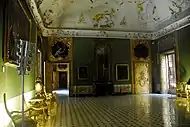
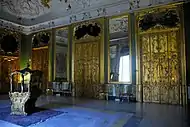
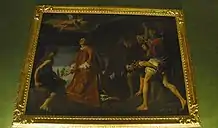
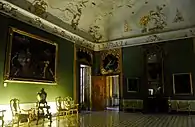

References
- (in Italian) Gaspare Palermo, "Guida istruttiva per potersi conoscere ... tutte le magnificenze ... della Città di Palermo", Volume III, Palermo, Reale Stamperia, 1816, page 217.
- Palazzo Alliata di Villafranca
- Francesco Alliata, "Il Mediterraneo era il mio regno: Memorie di un aristocratico siciliano" , Il Cammello Battriano, Neri Pozza Editore, Vicenza, 2015, ISBN 978-88-545-1110-1.
- "Vita da Gattopardo nel palazzo-labirinto" (PDF) (in Italian). 1 April 2017.
- "Palazzo Villafranca" (in Italian). Archived from the original on 2009-09-25.
- (in Italian) Gaspare Palermo, "Guida istruttiva per potersi conoscere ... tutte le magnificenze ... della Città di Palermo", Volume II, Palermo, Reale Stamperia, 1816, page 171}}.
- "Palermo, il Cinquecentesco Palazzo Villafranca diventerà un albergo in spregio al vincolo e alle leggi" (in Italian).
- "Si presenta il volume "Anton van Dyck e il restauro della Crocifissione Villafranca di Palermo"" (in Italian).
- "Palazzo Alliata di Villafranca di Palermo aderisce al circuito d'arte sacra" (in Italian). Museo Diocesano di Palermo.
External links
 Media related to Palazzo Alliata di Villafranca (Palermo) at Wikimedia Commons
Media related to Palazzo Alliata di Villafranca (Palermo) at Wikimedia Commons- Un viaggio all'interno dei fastosi saloni dello storico Palazzo Alliata di Villafranca, a Piazza Bologni (in Italian). Repubblica Tv - la Repubblica.it. 9 April 2017. Retrieved 10 April 2017.